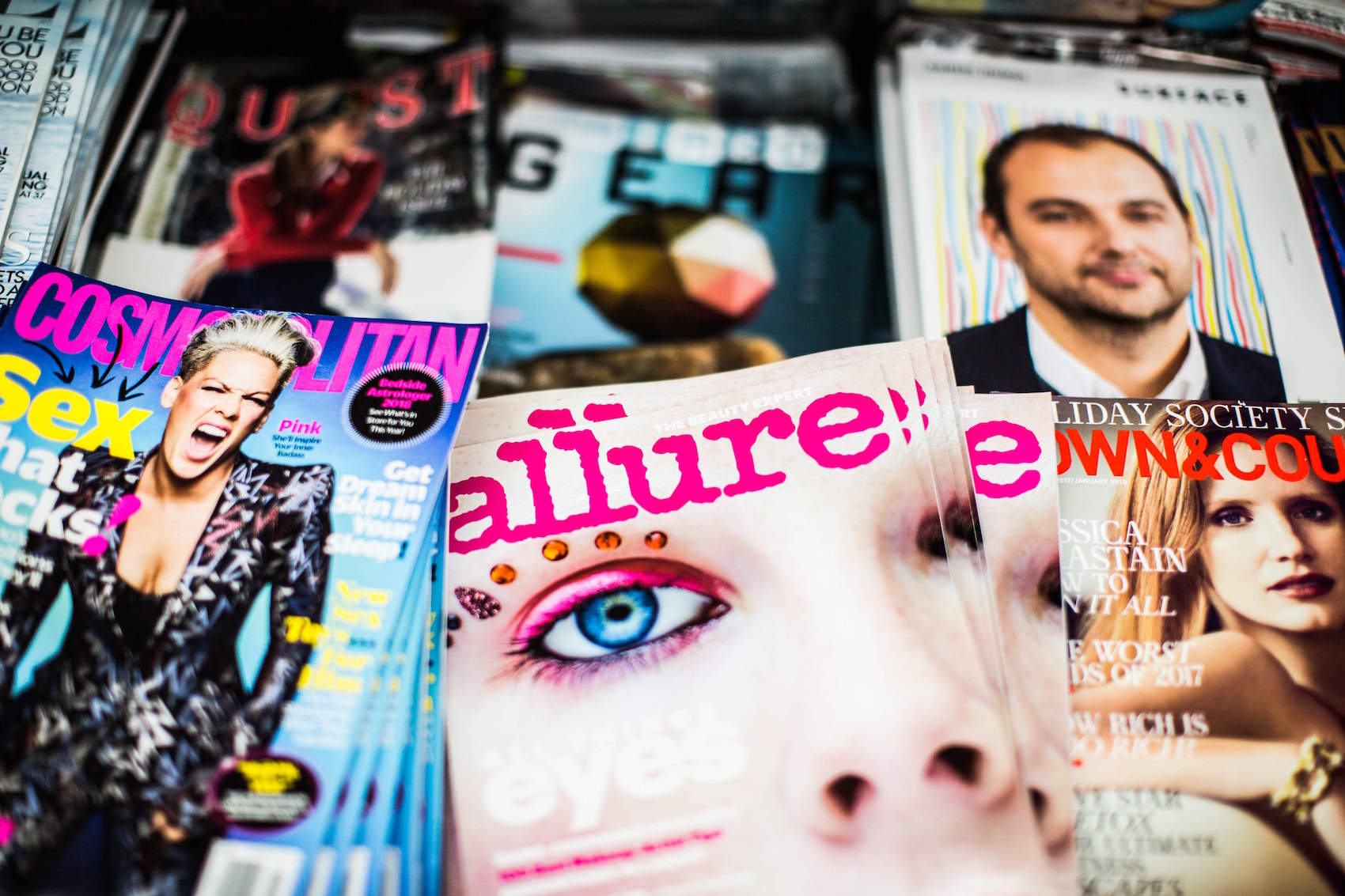When I started in magazines in 1996, it was a glamorous career. EICs pulled six-figure salaries (some seven) and it seemed every sitcom or rom-com heroine was a magazine editor, or trying to become one. This was when Cosmo and Glamour sold millions on the newsstand; there were “seven sisters” (let’s see if I can name them: Good Housekeeping, Redbook, Woman’s Day, McCall’s, Family Circle, Better Homes & Gardens, Ladies’ Home Journal); and celebrities like Oprah, Martha, and John Jr. were starting their own monthlies to compete. The industry was incredibly hard to break into. You had to know someone to get your resume to the top of the pile, and the pile was high. It helped if you lived in the tri-state area (you were more likely to know someone) and it helped if you were rich (ditto, but also so you could afford NYC rent on an unpaid or poorly paid internship).
I wasn’t rich. And I knew no one. But I could write a compelling essay, had four years of campus journalism experience on my resume, and luck on my side. I was accepted into the American Society of Magazine Editors’ internship program. At one of the networking lunches, I sat next to Good Housekeeping EIC Ellen Levine. She suggested I meet with her managing editor. I did, and after an extensive edit test and four more interviews, I got my first job as an editorial assistant. Soon after, I started Ed2010 to help other whippersnappers like myself from fly-over states land jobs in magazines. We were going to be editors in chief by 2010! We wanted to be the next Ellen Levine. Or Glenda Bailey. Or Tina Brown. We wanted tickets to the Met Gala, to be invited to the White House, have lunch with the famous and fabulous. Until then, we met for cheap beer downtown and swapped stories about our days in the assistant trenches and started a chat room on Yahoo’s Geo Cities (the cool thing to do in 1997) where gossip and “whisper” jobs could be posted. (Geocities.com/styx/5750 eventually became Ed2010.com).
Looking back, I realize that my first job paid pretty well ($38,500 in today’s dollars). On top of that I got full benefits, and on-the-job training. I learned to edit under the close eye of a legendary editor (hi Diane B!), and soaked up everything she and my top editors said in ideas meetings and wrote in the margins of my copy. I learned a ton and along with the seven other EA’s on staff (hi Susan!), enjoyed staying late to read the “slush” pile and cut potential stories out of local newspapers. We were rewarded with lots of perks. It was common practice among my junior-level coworkers to expense our meals and cabs home (sanctioned if you ate at your desk and stayed till 8 p.m., a small price to pay when you didn’t go to work till 10). I also expensed my cable bill and every movie I saw or CD I bought: they were “research” when I worked in entertainment at Glamour. Drinks were often paid for by PR firms luring you to check out their products, and freebies were so abundant you barely had to shop. For two decades, the most I paid for a beauty product was $2 (at a “closet sale” where we priced the freebies and gave the kitty to charity).
The perks were great, but the best part about being in magazines was if you worked hard, which I did, you’d be rewarded for it. It’s what today’s corporate psychologists like to call “grit” (before it was a buzzword): If you had it, you’d be rewarded with a promotion every few years and a salary jump, one that made a palpable difference in your life. If there was no movement within your department, but you had talent and persistence, you could count on landing a great opportunity at a competitor. At 25, I leapt from a $65K gig at YM to a $95K role at Cosmo. Nearly six figures at 25! In fact the industry was so flush that in my 20s, I moved around to five different magazines, each providing me with compelling new challenges and the financial stability to eventually buy my first apartment in Manhattan, travel to exotic places on vacation, and even pay for half a mortgage and private preschool for two kids.
While I’m sure isolated opportunities for advancement still exist, a rain cloud has been over the industry since the 2008 recession. Other business sectors slowly bounced back, their workforces grown, and their salaries risen. But the consumer magazine industry did not. The cloud only grew darker. At first a couple titles would fold each year (Gourmet, Ladies Home Journal, Details … ) and our editors would segue into gigs as freelance writers, web editors, or book authors. Then the layoffs started. In the beginning, they were once a year and squeezed out an extra layer of hierarchy, a bad hire, or one of the two assistants to the EIC. Then the layoffs happened twice a year and we got down to one assistant per staff, promotions and raises were frozen indefinitely, and the top editors who could mentor junior ones became an endangered species. Then the rounds of layoffs became quarterly. That’s when editors started working in “hubs” for multiple titles, a prospective hire would linger in an approval chain for months before the position was eliminated altogether, and we couldn’t even afford an intern. Now? Well, I have a friend at Hearst whose boss was let go three weeks ago. Then she was let go the next week. They don’t even bother to have “rounds” anymore.
For the longest time, I said I’d go down with the ship. I loved magazines and nothing else compared. Not digital or marketing or PR or even running my own business. But then I became one of the last in my group of friends who had a full-time job in print. There’s a photo of my 30th birthday with my nine closest girlfriends – then we worked at Glamour, Ladies’ Home Journal, CosmoGirl, Allure, Seventeen, Fitness, and Cosmo. Only one remains: she’s still at Glamour (hi Wendy!). The rest of us were forced to move on: 2 yoga teachers, 2 freelance writers, 1 graduate student in social work, 1 EIC of a website, 1 marketing director, and me. I now work in branded content (and actually do love it, but that’s a different post).
My team at Ed2010 — once all die-hard print magaziners because that was the point — is made up 30 volunteers (down from about 45) that edit our content, ran our campus chapters, scholarship program, and mentor service, post our jobs, and organize our workshops, panels, and happy hours. I used to require that to be on the Ed2010 team you had to work full-time in print. If I required that today, we’d have a team of two (hi Karen and Sarah!).
No surprise that most of the jobs we post on Ed2010 these days are digital ones. There are about a quarter of the internships that there were five years ago. The vast majority of entry-level jobs are full-time freelance with no benefits (some cheerfully note, “only up to 1,000 hours!”) and none pay more than $20/hour. (I still refuse to post jobs unless they pay minimum wage, but it’s tricky to monitor when they are “project-based,” which it seems everything is.) Several years ago, I switched the focus of Ed2010 to include careers in digital publishing. But the opportunities aren’t much better. The layoffs have hit digital as well, and the pay hasn’t budged. Alas, digital is not the answer.
Meanwhile, Ed2010 still has a dozen active Ed on Campus chapters run by college students across the country. Scrappy, enthusiastic whippersnappers start chapters because they want to go into magazine media and the support of Ed2010 to do so. For nearly 20 years we’ve offered resume critiques, hosted virtual panel discussions, and organized student tours at NYC magazine offices. Ed2010 team members and I have hosted countless tours, and always poll the students, each year asking who wants a career in print and who wants a career in digital. Print still edges out digital. I’ve stopped asking Why. My best guess is the glamour myth is a hard one to squelch.
Last week, a young woman from a large state university reached out to me. With her professor copied, she wrote a flattering email saying how much she admired me and my career. Like hundreds of students before her, she wrote passionately about how she was pursuing the same path I did, applying to become an ASME intern. She was eager to start an Ed on Campus chapter at her school and wanted my blessing. My heart sank.
It was time to make a decision. I told her what I’m now telling all of you: The consumer magazine industry is no longer the vibrant, exciting industry it once was. And as much as it breaks my heart to say this: It is no longer a viable industry to build a career within. Sadly, I feel continuing to support and encourage the growth of new Ed on Campus chapters is disingenuous and fosters false hope to the students Ed has tried to help for so long. After much discussion and debate among my Ed on Campus team, Ed2010 will not accept new Ed on Campus chapters for Fall 2018. We will allow the chapters that currently exist to continue under their same leadership, and we will support them. But we will not be accepting new chapters.
Ed2010 is still all-in on helping young people use their editorial talents to find their dream careers — there are many, many options that I can’t get into here (this post is long enough, is it not?). Ed will continue to exist as a resource hub for students and junior-level editors looking for realistic advice in the media industry, with a shifted focus to editorial content in general (think social media, branded, digital with a sprinkling of print). And we will continue to post internships, temp positions, and full-time jobs on our jobs board and in our weekly newsletter — at least for now. As long as I feel that Ed2010 fulfills its original mission of helping whippersnappers reach their dream jobs, Ed will have a place. As soon as it no longer does, Ed too will be laid off, along with thousands of his highly talented, deeply loved peers.
Chandra Turner is the founder and president of Ed2010. After 22 years in consumer magazines, she is now the executive director of Scholastic National Partnerships.



 10 Fun Magazine Facts to Share Over Coffee
10 Fun Magazine Facts to Share Over Coffee